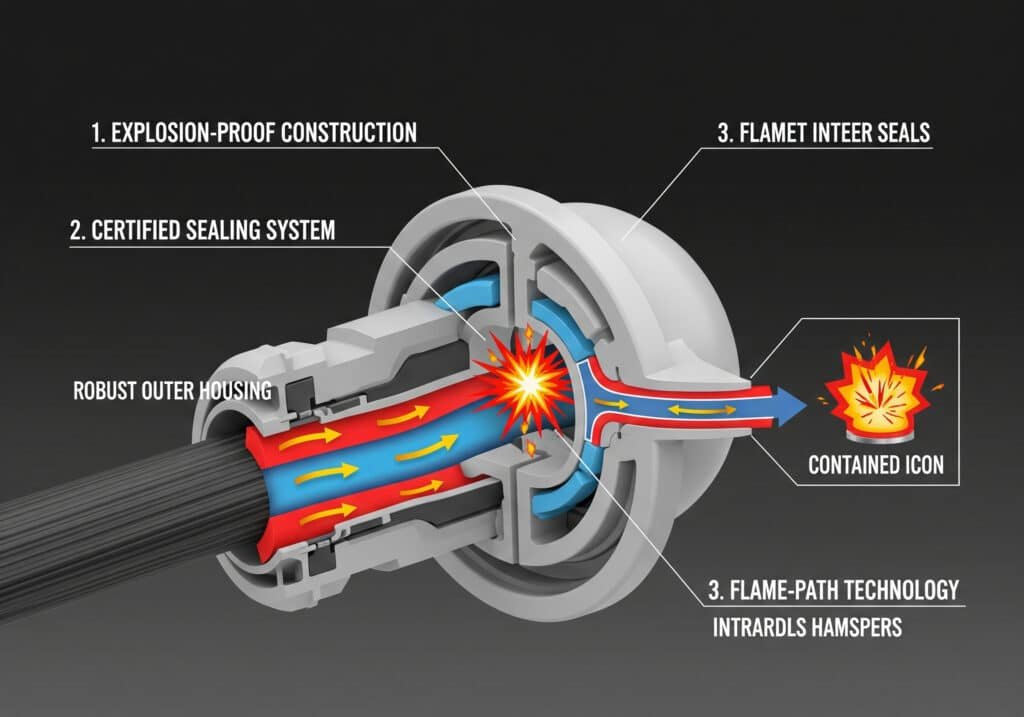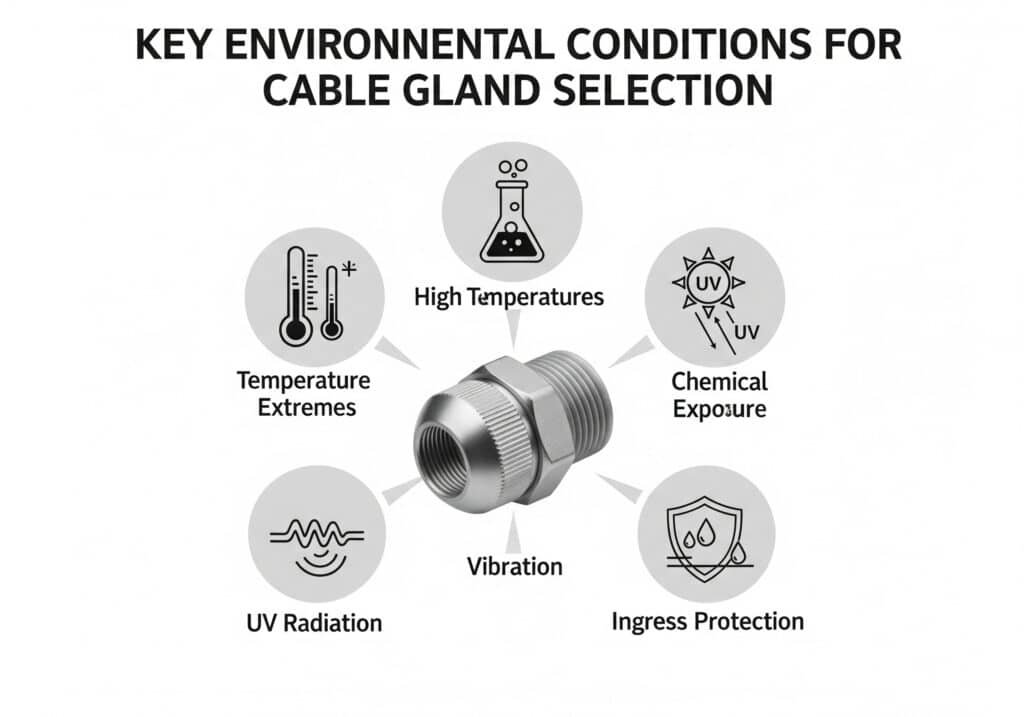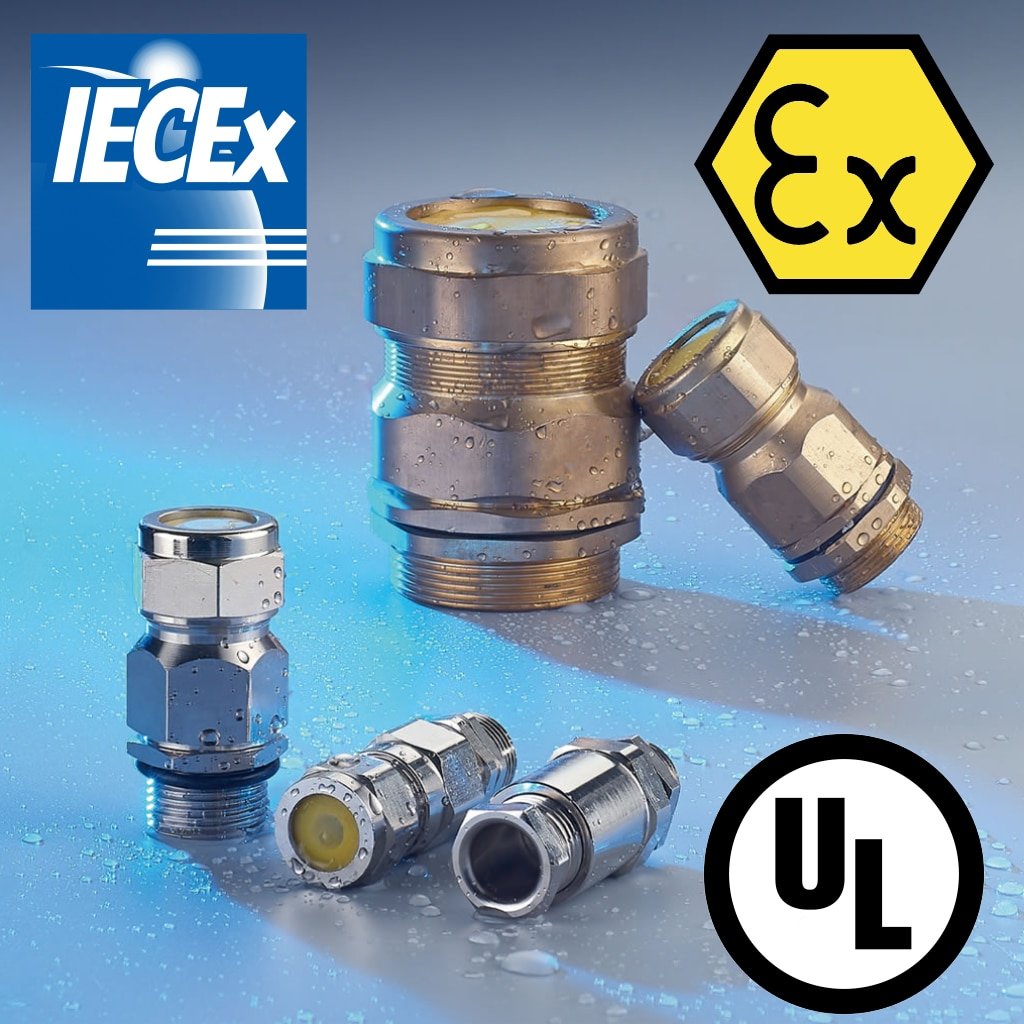Introduction
Working in hazardous areas where explosive gases, vapors, or dust particles pose constant threats? You’re not alone in feeling overwhelmed by the complexity of selecting the right cable gland. One wrong choice could lead to catastrophic equipment failure, safety violations, or worse – putting lives at risk.
The key to selecting the perfect cable gland for hazardous areas lies in understanding three critical factors: the specific hazardous zone classification, required certification standards (ATEX1, IECEx, UL), and environmental conditions including temperature, chemical exposure, and ingress protection requirements.
I’ve witnessed countless engineers struggle with this decision, often discovering their initial selection was inadequate only after installation. Last month, David, a procurement manager from a petrochemical facility in Texas, contacted us in panic after realizing his current cable glands lacked proper ATEX certification for their Zone 1 application. Let me guide you through this critical selection process to avoid such costly mistakes.
Table of Contents
- What Makes Cable Glands Suitable for Hazardous Areas?
- How Do You Determine Your Hazardous Zone Classification?
- Which Certification Standards Should You Prioritize?
- What Material Selection Factors Matter Most?
- How Do Environmental Conditions Impact Your Choice?
- FAQs About Hazardous Area Cable Glands
What Makes Cable Glands Suitable for Hazardous Areas?
Ever wondered why regular cable glands simply won’t cut it in explosive environments? The answer lies in specialized design features that prevent ignition sources.
Hazardous area cable glands incorporate explosion-proof construction, certified sealing systems, and flame-path technology2 to prevent internal explosions from propagating to the external atmosphere, ensuring safe operation in potentially explosive environments.

Key Design Features
Standard cable glands focus primarily on environmental sealing, but hazardous area versions must meet stringent safety requirements:
- Explosion-proof enclosures with precise flame-path dimensions
- Certified sealing compounds that maintain integrity under extreme conditions
- Anti-static materials to prevent electrostatic discharge
- Temperature-resistant construction for high-heat applications
The difference became crystal clear when Hassan, who owns a refinery in Kuwait, shared his experience. After a near-miss incident with standard cable glands in his Zone 1 area, he realized the critical importance of proper explosion-proof certification. “Chuck,” he told me, “I never understood why explosion-proof glands cost more until I saw what could happen without them.”
Certification Requirements
Unlike standard applications, hazardous area installations demand third-party certification from recognized bodies:
| Certification | Region | Key Standards |
|---|---|---|
| ATEX | Europe | EN 60079 series |
| IECEx | International | IEC 60079 series |
| UL/CSA | North America | UL 1203, CSA C22.2 |
| PESO | India | IS/IEC 60079 |
At Bepto, we maintain comprehensive certification portfolios including ATEX, TUV, and PESO approvals for our explosion-proof cable glands, ensuring global compliance for your critical applications.
How Do You Determine Your Hazardous Zone Classification?
Feeling confused by Zone 0, Zone 1, Zone 2 classifications? You’re not alone – this is where most engineers get stuck.
Hazardous zone classification depends on the frequency and duration of explosive atmosphere presence: Zone 0 (continuous), Zone 1 (occasional during normal operation), and Zone 2 (abnormal conditions only), with each requiring progressively less stringent equipment protection levels.
Zone Classification Breakdown
Understanding your specific zone determines the required Equipment Protection Level (EPL)3:
Zone 0 (EPL Ga):
- Explosive atmosphere present continuously
- Requires the highest protection level
- Examples: Inside storage tanks, vapor spaces
Zone 1 (EPL Gb):
- Explosive atmosphere likely during normal operation
- Moderate protection requirements
- Examples: Near tank vents, pump areas
Zone 2 (EPL Gc):
- Explosive atmosphere unlikely except under abnormal conditions
- Basic protection sufficient
- Examples: General plant areas, control rooms
Practical Assessment Steps
When David from that Texas petrochemical plant called us, his first question was: “How do I even know what zone I’m in?” Here’s the systematic approach I shared:
- Review your facility’s hazardous area drawings – These should indicate zone boundaries
- Consult with your safety engineer – They understand the specific risks
- Consider the worst-case scenarios – What happens during maintenance or equipment failure?
- Factor in ventilation effectiveness – Poor ventilation elevates zone classification
Remember, when in doubt, always err on the side of caution and select equipment rated for a higher protection level.
Which Certification Standards Should You Prioritize?
Overwhelmed by the alphabet soup of certifications? Let me simplify this crucial decision for you.
Prioritize certifications based on your geographic location and end-market requirements: ATEX for European markets, UL/CSA for North America, IECEx for international projects, and always verify specific local requirements with authorities having jurisdiction4.
Regional Certification Priorities
European Union & Export Markets:
- ATEX Directive 2014/34/EU (mandatory for EU)
- IECEx certification (widely accepted internationally)
- CE marking for general product compliance
North American Markets:
- UL 1203 (United States)
- CSA C22.2 No. 30 (Canada)
- Class I, Division 1/2 or Zone 0/1/2 ratings
Emerging Markets:
- PESO certification (India – mandatory for local projects)
- NEPSI (China – for domestic installations)
- KOSHA (South Korea – specific applications)
Certification Verification Process
Hassan’s experience taught me the importance of proper verification. When he initially sourced cable glands for his Kuwait refinery, he assumed all “explosion-proof” products were equivalent. After our technical review, we discovered several critical gaps:
- Missing ATEX certification for Zone 1 application
- Incorrect temperature class rating
- Inadequate IP rating for outdoor installation
We provided properly certified alternatives with:
- ATEX Ex d IIC T6 certification
- IP68 rating for harsh outdoor conditions
- Stainless steel 316L construction for chemical resistance
The lesson? Always request certification documents and verify they match your specific application requirements.
What Material Selection Factors Matter Most?
Choosing between brass, stainless steel, or aluminum can make or break your installation’s longevity and safety.
Material selection for hazardous area cable glands depends on chemical compatibility, temperature requirements, and corrosion resistance needs, with stainless steel 316L being the gold standard for aggressive chemical environments and marine applications.
Material Comparison Matrix
| Material | Temperature Range | Chemical Resistance | Cost Factor | Best Applications |
|---|---|---|---|---|
| Brass (Nickel-plated) | -40°C to +100°C | Moderate | Low | General industrial, dry environments |
| Stainless Steel 316L | -60°C to +200°C | Excellent | High | Chemical plants, marine, food processing |
| Aluminum | -50°C to +150°C | Good | Medium | Lightweight applications, non-corrosive environments |
Real-World Material Challenges
David’s Texas facility presented a perfect case study in material selection challenges. Their initial brass cable glands showed significant corrosion after just six months in their hydrogen sulfide environment5. We recommended upgrading to 316L stainless steel with the following benefits:
- Superior chemical resistance to H2S and other corrosive gases
- Extended service life reducing maintenance costs
- Maintained certification integrity under harsh conditions
- Cost-effective long-term solution despite higher initial investment
Special Considerations
High-Temperature Applications:
- Consider thermal expansion coefficients
- Verify certification temperature ratings
- Evaluate seal material compatibility
Chemical Exposure:
- Review chemical compatibility charts
- Consider galvanic corrosion potential
- Evaluate cleaning/decontamination requirements
Marine Environments:
- Prioritize 316L stainless steel construction
- Verify salt spray test compliance
- Consider additional protective coatings
How Do Environmental Conditions Impact Your Choice?
Environmental factors can quickly turn a perfect cable gland selection into a maintenance nightmare if overlooked.
Environmental conditions including temperature extremes, chemical exposure, UV radiation, vibration, and ingress protection requirements directly influence cable gland material selection, sealing technology, and certification requirements for reliable long-term performance.

Critical Environmental Factors
Temperature Considerations:
- Ambient temperature range affects material selection
- Internal heat generation from electrical loads
- Thermal cycling stress on seals and connections
- Certification temperature class requirements (T1-T6)
Ingress Protection (IP) Requirements:
- IP66: Protection against powerful water jets
- IP67: Protection against temporary immersion
- IP68: Protection against continuous submersion
- IP69K: High-pressure, high-temperature washdown
Chemical Environment Assessment:
- Identify specific chemicals present
- Consider concentration levels and exposure duration
- Evaluate cleaning agents and decontamination procedures
- Review material compatibility data sheets
Installation Environment Challenges
Hassan’s refinery project highlighted several environmental challenges we hadn’t initially considered:
Desert Climate Factors:
- Extreme temperature variations (-10°C to +60°C)
- Sand and dust ingress concerns
- UV degradation of polymer components
- Thermal expansion stress on connections
Our Solution Package:
- 316L stainless steel construction for temperature stability
- IP68 rating with enhanced seal design
- UV-resistant cable entry seals
- Thermal expansion compensation features
Vibration and Mechanical Stress:
- Equipment-mounted installations experience constant vibration
- Thermal cycling creates expansion/contraction stress
- Wind loading on outdoor installations
- Seismic considerations in earthquake-prone areas
Maintenance Accessibility
Don’t overlook the practical aspects of installation and maintenance:
- Accessibility for inspection – Can you easily verify seal integrity?
- Maintenance space requirements – Adequate clearance for cable pulling
- Tool requirements – Standard tools vs. specialized equipment
- Spare parts availability – Local stock vs. long lead times
Conclusion
Selecting the right cable gland for hazardous areas isn’t just about meeting minimum requirements – it’s about ensuring long-term safety, reliability, and cost-effectiveness. The key lies in understanding your specific zone classification, prioritizing appropriate certifications, selecting compatible materials, and thoroughly evaluating environmental conditions. Remember David’s lesson about proper ATEX certification and Hassan’s experience with material selection – these real-world examples demonstrate why thorough upfront analysis saves both money and potential safety incidents. At Bepto, we’re committed to helping you navigate these complex decisions with our comprehensive product range, global certifications, and decade of specialized experience in hazardous area applications.
FAQs About Hazardous Area Cable Glands
Q: What’s the difference between ATEX and IECEx certification for cable glands?
A: ATEX is the European Union directive mandatory for EU markets, while IECEx is an international certification scheme accepted globally. ATEX focuses on EU regulatory compliance, whereas IECEx provides broader international recognition with similar technical requirements.
Q: Can I use Zone 2 rated cable glands in Zone 1 applications?
A: No, you cannot use lower-rated equipment in higher-risk zones. Zone 1 applications require EPL Gb rated equipment, while Zone 2 equipment is only EPL Gc rated. Always use equipment rated for your specific zone or higher.
Q: How do I determine the correct temperature class for my application?
A: Measure the maximum ambient temperature plus any heat generated by electrical equipment. The cable gland’s T-rating must exceed this total. For example, T6 rating allows maximum 85°C surface temperature, suitable for most industrial applications.
Q: What IP rating do I need for outdoor hazardous area installations?
A: Outdoor installations typically require minimum IP66 for weather resistance, but IP67 or IP68 is recommended for harsh environments. Consider factors like direct water exposure, submersion risk, and high-pressure washdown requirements.
Q: Are brass cable glands suitable for chemical plant applications?
A: Brass cable glands work well in general industrial environments but may corrode in aggressive chemical atmospheres. For chemical plants, stainless steel 316L construction provides superior corrosion resistance and longer service life despite higher initial cost.
-
Access the official European Commission page for the ATEX Directive 2014/34/EU on equipment for explosive atmospheres. ↩
-
Understand the engineering principles of a flame path and how it prevents the propagation of an internal explosion. ↩
-
Learn about the different Equipment Protection Levels (EPLs) as defined by the IEC 60079 series of standards. ↩
-
Discover the role and importance of the Authority Having Jurisdiction (AHJ) in regulatory compliance and safety approvals. ↩
-
Explore the corrosive effects of hydrogen sulfide (H₂S) gas on various metals, including brass and stainless steel. ↩



